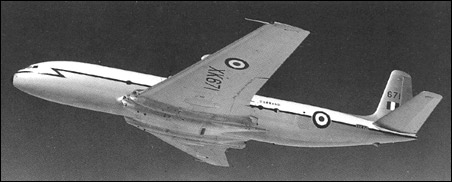 |
De Havilland D.H.106 Comet1949 |  |
| PASSENGER | Virtual Aircraft Museum / United Kingdom / De Havilland |
 |
The Comet was the world's first jet transport to enter service. It resulted from the wartime Brabazon Committee's recommendations for the Type IV North Atlantic turbojet mail plane, which led to numerous studies including a 20-passenger aircraft with three rear-mounted Goblin engines. The final design emerged as an orthodox low-wing monoplane with 20° leading-edge sweep-back and four 19.8kN de Havilland Ghost centrifugal-flow turbojets buried in the wing roots. Initial accommodation was for 36 passengers in two cabins, pressurised to provide internal pressure equivalent to 2,438m when flying at 12,192m. Cruising speed was about 788km/h. The prototype Comet made its first flight on 27 July 1949. BOAC received a fleet often Comet Is and on 2 May 1952 inaugurated the first passenger services to be operated by turbojet aircraft - on the London-Johannesburg route, covering the 10,821km in 23 hr 34 min. Comets were subsequently introduced on a number of routes, bringing drastic cuts in journey time: such as the reduction from 86 to 33 1/4 hours between London and Tokyo. Air France and UAT soon began Comet services and there were a number of airline orders for Comet 1s and later models when one broke up near Calcutta exactly a year after its introduction; in January and April 1954 two more suffered inflight structural failure, resulting in the type being withdrawn. The Avon-powered Comet 2s on order for BOAC were strengthened and some delivered to the RAF. A longer-fuselage long-range Comet 3 had been developed and in the light of the inquiry into the Comet 1s disasters it was redesigned, first flying on 19 July 1954. It did not go into production but made a round-the-world flight and served as a test vehicle. In 1957 it was decided that Comets would be reinstated and BOAC ordered 19 Comet 4s. These were powered by 46.71kN Rolls-Royce Avon 524, had longer fuselages than the Comet 1 and could carry 60-81 passengers. The first Comet 4 flew on 27 April 1958 and on 4 October BOAC Comets inaugurated North Atlantic jet services (in both directions simultaneously) over the London-New York route - a route for which they did not have adequate range. From that time Comets took over much of BOAC's network. Other Comet 4s were used by Aerolineas Argentinas, East African Airways and the RAF. From this version were developed the Comet 4B and 4C which first flew on 27 June and 31 October 1959 respectively. The Comet 4B had a 1.98m increase in fuselage length, a 2.13m reduction in span and was intended for high-speed operation over shorter stages. It could carry up to 101 passengers and was not fitted with wing-mounted external fuel tanks. The main operators of Comet 4B were British European Airways and Olympic Airways. The Comet 4C combined the long fuselage of the Comet 4B with the standard Comet 4 wing. This version was ordered by several airlines and went into service in 1960. A total of 112 Comets were built including 74 Series 4 aircraft; and the type was subsequently developed into the RAF Nimrod.
|  COMPANY PROFILE | |||||||||||||||||||||||||||||||||||||||||||||||||||||||||||||||
 |

|


